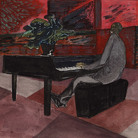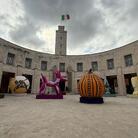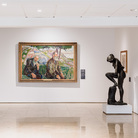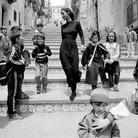SupaVenezia

Soi13 by Flore Mycek
Dal 31 August 2022 al 25 September 2022
Venezia
Luogo: A plus A gallery
Indirizzo: Calle Malipiero 3073
Curatori: Studenti della School for Curatorial Studies Venice
Sito ufficiale: http://www.aplusa.it
La galleria A plus A ospita dal 31 agosto 2022 la prima edizione italiana di SupaStore, un progetto ideato dall’artista e curatrice Sarah Staton nel 1993 a Londra. L'edizione veneziana è curata dagli studenti della School for Curatorial Studies Venice ed è un evento ufficiale della Venice International Glass Week 2022.
Ospitato in decine di destinazioni internazionali, tra cui New York (SupaStore Luxe . 1996, SupaStore Noir - 1997), Bregenz (SupaStore in the Mountains - 1998), Vienna, (SupaStore Sleep -2014), Berlino (SupaStore Tina - 2015) e Lituania (SupaStore NIDA – 2020) e Corea del Sud (SupaStore Pressure Drop - 2021), durante i suoi oltre venticinque anni di carriera, la mostra ha ospitato artisti come Andy Warhol, Jeff Koons, Damien Hirst, Chris Ofili, Tracy Emin e Fiona Banner.
SupaVenezia esplora la pratica dello shopping come attività sociale, comunitaria, politica ed economica, mettendo in discussione i meccanismi neocapitalistici del mercato dell’arte. SupaStore ricalca l’idea di mercato esponendo un vasto numero di opere in edizione di multipli: un mezzo per rendere l’arte più accessibile sul versante economico e che ci invita a riconsiderare gli ideali di esclusività e autenticità. Le opere esposte, molte delle quali ideate appositamente per la mostra, abbattono così le barriere che intercorrono tra mercato dell’arte e visitatori, proponendo prezzi più accessibili e alla portata di tutti.
Alla base del consumismo, la produzione seriale degli oggetti permette un abbassamento dei prezzi con consequenziale allargamento del pubblico, un processo che in questo contesto viene applicato all’arte. Multipli, libri d’artista e non solo si potranno trovare nel SupaStore dove piccoli dettagli o impercettibili interventi concorreranno a rendere poetiche certe digressioni sull’impossibilità di avere due lavori identici.
Voci multiformi e corali si fondono in un caleidoscopio di più di trenta artisti e 16 giovani curatori provenienti da Australia, Sud Corea, Usa, Taiwan, Svizzera, Messico, Pakistan, Ucraina, Kazakistan, Brasile, Canada e Italia, che attraverso questa mostra in continuo cambiamento intendono questionare non solo l’odierno mercato dell’arte ma anche una società in cui benessere è spesso sinonimo di autodistruzione. Un processo che vede in Venezia un esempio emblematico. In mostra opere di: Francesca Anfossi, Taylor Carruthers, Nina Ceranic, Giorgia Agnese Cereda, Guendalina Cerutti, Kate Davis and David Moore, Saule Dyussembina, Julia Frank, Zuza Golinska, Melanie Jackson, Hetty Laycock, Steph Huang, Min Joon Park, Jaspar Joseph Lester, Cosima Montavoci, Flore Mycek, Irina Ozarinskaja, Cullinan Richards, Filippo Rizzonelli, Henrique Schmeil, Ioana Maria Sisea, Francesco Snote, Patricio Tejedo, Jake Tilson, Fabiano Vicentini, CHiNGLiSH WANG, Maria Xilo, Camille Yvert. Per la giornata di apertura sarà offerto un calice di prosecco della cantina Le Bertole®, per la quale è stata realizzata un'etichetta d'artista. Parte del ricavato delle opere in vendita di SupaVenezia sarà devoluto a We are here Venice, un’organizzazione indipendente senza scopo di lucro dedicata alla salvaguardia di Venezia come città viva. Inoltre, durante tutto il periodo di apertura sarà attivo un punto di raccolta donazioni per l'associazione presso gli spazi della galleria A plus A. https://www.weareherevenice.org/ Il progetto è realizzato con il supporto di Royal College of Art.
Vernice il 31 agosto 2022 alle ore 18.00
Ospitato in decine di destinazioni internazionali, tra cui New York (SupaStore Luxe . 1996, SupaStore Noir - 1997), Bregenz (SupaStore in the Mountains - 1998), Vienna, (SupaStore Sleep -2014), Berlino (SupaStore Tina - 2015) e Lituania (SupaStore NIDA – 2020) e Corea del Sud (SupaStore Pressure Drop - 2021), durante i suoi oltre venticinque anni di carriera, la mostra ha ospitato artisti come Andy Warhol, Jeff Koons, Damien Hirst, Chris Ofili, Tracy Emin e Fiona Banner.
SupaVenezia esplora la pratica dello shopping come attività sociale, comunitaria, politica ed economica, mettendo in discussione i meccanismi neocapitalistici del mercato dell’arte. SupaStore ricalca l’idea di mercato esponendo un vasto numero di opere in edizione di multipli: un mezzo per rendere l’arte più accessibile sul versante economico e che ci invita a riconsiderare gli ideali di esclusività e autenticità. Le opere esposte, molte delle quali ideate appositamente per la mostra, abbattono così le barriere che intercorrono tra mercato dell’arte e visitatori, proponendo prezzi più accessibili e alla portata di tutti.
Alla base del consumismo, la produzione seriale degli oggetti permette un abbassamento dei prezzi con consequenziale allargamento del pubblico, un processo che in questo contesto viene applicato all’arte. Multipli, libri d’artista e non solo si potranno trovare nel SupaStore dove piccoli dettagli o impercettibili interventi concorreranno a rendere poetiche certe digressioni sull’impossibilità di avere due lavori identici.
Voci multiformi e corali si fondono in un caleidoscopio di più di trenta artisti e 16 giovani curatori provenienti da Australia, Sud Corea, Usa, Taiwan, Svizzera, Messico, Pakistan, Ucraina, Kazakistan, Brasile, Canada e Italia, che attraverso questa mostra in continuo cambiamento intendono questionare non solo l’odierno mercato dell’arte ma anche una società in cui benessere è spesso sinonimo di autodistruzione. Un processo che vede in Venezia un esempio emblematico. In mostra opere di: Francesca Anfossi, Taylor Carruthers, Nina Ceranic, Giorgia Agnese Cereda, Guendalina Cerutti, Kate Davis and David Moore, Saule Dyussembina, Julia Frank, Zuza Golinska, Melanie Jackson, Hetty Laycock, Steph Huang, Min Joon Park, Jaspar Joseph Lester, Cosima Montavoci, Flore Mycek, Irina Ozarinskaja, Cullinan Richards, Filippo Rizzonelli, Henrique Schmeil, Ioana Maria Sisea, Francesco Snote, Patricio Tejedo, Jake Tilson, Fabiano Vicentini, CHiNGLiSH WANG, Maria Xilo, Camille Yvert. Per la giornata di apertura sarà offerto un calice di prosecco della cantina Le Bertole®, per la quale è stata realizzata un'etichetta d'artista. Parte del ricavato delle opere in vendita di SupaVenezia sarà devoluto a We are here Venice, un’organizzazione indipendente senza scopo di lucro dedicata alla salvaguardia di Venezia come città viva. Inoltre, durante tutto il periodo di apertura sarà attivo un punto di raccolta donazioni per l'associazione presso gli spazi della galleria A plus A. https://www.weareherevenice.org/ Il progetto è realizzato con il supporto di Royal College of Art.
Vernice il 31 agosto 2022 alle ore 18.00
SCARICA IL COMUNICATO IN PDF
omar galliani
·
julia frank
·
a plus a gallery
·
cosima montavoci
·
giorgia agnese cereda
·
galleria delle arti di luigi amadei
·
francesca anfossi
·
taylor carruthers
·
nina ceranic
·
guendalina cerutti
·
kate davis and david moore
·
saule dyussembina
·
zuza golinska
·
melanie jackson
·
hetty laycock
·
steph huang
·
min joon park
·
jaspar joseph lester
·
flore mycek
·
irina ozarinskaja
COMMENTI

-
 Dal 5 November 2025 al 1 March 2026
Asti | Palazzo Mazzetti
Dal 5 November 2025 al 1 March 2026
Asti | Palazzo Mazzetti
PAOLO CONTE. Original
-
 Dal 28 October 2025 al 15 February 2026
Brescia | Pinacoteca Tosio Martinengo
Dal 28 October 2025 al 15 February 2026
Brescia | Pinacoteca Tosio Martinengo
Peter Paul Rubens. Giovan Carlo Doria a cavallo
-
 Dal 31 October 2025 al 21 March 2026
Rovereto | Mart Rovereto
Dal 31 October 2025 al 21 March 2026
Rovereto | Mart Rovereto
Le sfide del corpo
-
 Dal 31 October 2025 al 15 February 2026
Roma | Museo del Genio
Dal 31 October 2025 al 15 February 2026
Roma | Museo del Genio
Vivian Maier. The exhibition / Pop Air. Ugo Nespolo
-
 Dal 30 October 2025 al 1 March 2026
Venezia | Centro Culturale Candiani
Dal 30 October 2025 al 1 March 2026
Venezia | Centro Culturale Candiani
Munch e la rivoluzione espressionista
-
 Dal 24 October 2025 al 1 March 2026
Saluzzo | La Castiglia
Dal 24 October 2025 al 1 March 2026
Saluzzo | La Castiglia
Ferdinando Scianna. La moda, la vita


